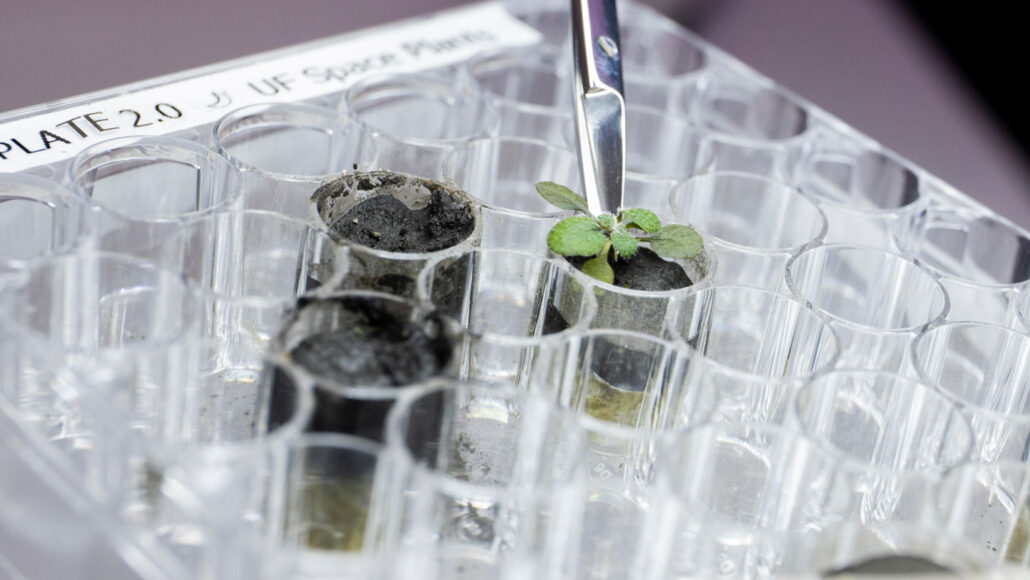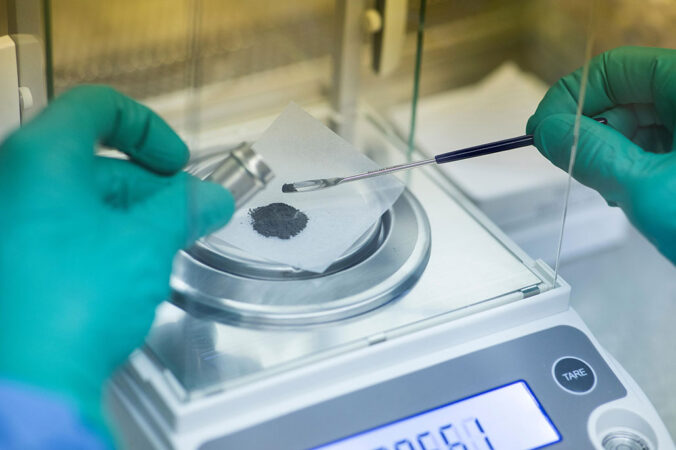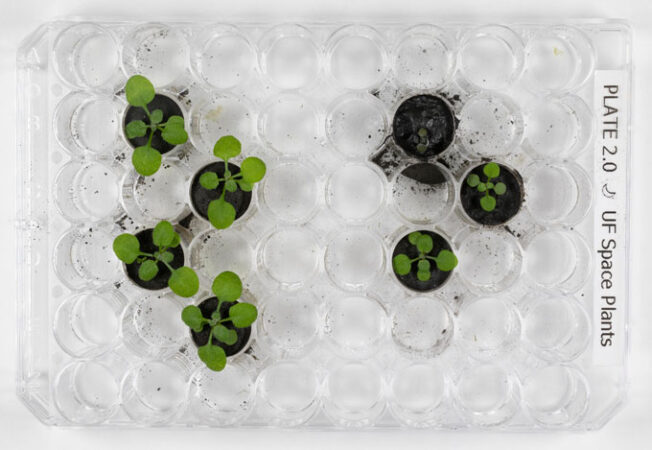The first plants ever grown in moon dirt have sprouted
This tiny garden shows farming on the moon may be difficult, though not impossible

This thale cress plant sprouted from a seed potted in lunar dirt that was collected by Apollo astronauts.
Tyler Jones, IFAS/UF
That’s one small stem for a plant, one giant leap for plant science.
In a tiny, lab-grown garden, the first seeds ever sown in lunar dirt have sprouted. This small crop was planted in samples returned by the Apollo missions roughly 50 years ago. And its success offers hope that astronauts might someday grow their own food on the moon.
But there’s a catch. Plants potted in lunar dirt were far scrawnier than those grown in volcanic material from Earth. Moon-grown plants also grew more slowly than those nourished in earthly material. These findings suggest that farming on the moon would take a lot more than a green thumb.
Researchers shared the results May 12 in Communications Biology.
“Ah! It’s so cool!” says Richard Barker of the experiment. Barker was not involved in the work, but he also studies how plants could grow in space. He works at the University of Wisconsin–Madison.
“Ever since these samples came back, there’s been botanists that wanted to know what would happen if you grew plants in them,” Barker says. “But everyone knows those precious samples … are priceless. And so you can understand why [NASA was] reluctant to release them.”
Now, NASA is planning to send people back to the moon as part of its Artemis program. Those plans have offered a new incentive to find out how well the moon’s resources might support long-term missions.
@sciencenewsofficial The first attempt to garden in lunar dirt shows that growing food on the moon may be hard, but not impossible. #moon #plants #science #learnitontiktok
♬ original sound – sciencenewsofficial
Lunar farming
Called regolith, the soil that covers the moon is basically a gardener’s worst nightmare. This fine powder is made up of razor-sharp bits. It’s full of metallic iron, rather than the oxidized type of iron that plants can use. It’s also full of tiny shards of glass forged by space rocks pelting the moon. What it is not full of is nitrogen, phosphorus or other nutrients that plants need to grow.
Scientists have gotten pretty good at coaxing plants to grow in fake moon dust made of earthly materials. But given how harsh the real stuff is, no one knew whether newborn plants could put down their delicate roots in it.

A trio of researchers at the University of Florida in Gainesville wanted to find out. They ran experiments with thale cress (Arabidopsis thaliana). This well-studied plant is in the same family as mustards and can grow in just a tiny clod of dirt. That was key, because the researchers had only a little bit of the moon to go around.
The team planted seeds in tiny pots. Each held about a gram of dirt. Four pots were filled with samples returned by Apollo 11. Another four were filled with Apollo 12 samples. A final four were potted with dirt from Apollo 17. In addition, 16 pots were filled with volcanic material from Earth. That mix has been used in past experiments to mimic moon dirt. All of the plants were grown under LED lights in the lab. They were watered with a broth of nutrients.
In short order, seeds sprouted in all the pots of lunar dirt. “That was a moving experience,” says Anna-Lisa Paul. She is a plant molecular biologist and a coauthor of the new study. Her team could now “say that we’re watching the very first terrestrial organisms to grow in extraterrestrial materials, ever. And it was amazing,” she adds. “Just amazing.”
But none of the seedlings in lunar dirt fared as well as those grown in earthly material. “The healthiest ones were just smaller,” Paul says. The sickliest moon-grown plants were tiny and purplish rather than green. That deep color is a red flag of plant stress.
Plants grown in Apollo 11 samples were the most stunted. That could be because this dirt had been exposed to the lunar surface the longest. As a result, it was littered with more impact glass and metallic iron than samples collected by the Apollo 12 and 17 missions.

Paul and her colleagues also inspected the genes of plants in their mini alien Eden. “Seeing what kind of genes are turned on and turned off in response to a stress … shows you what tools plants are pulling out of their [genetic] toolbox to deal with that stress,” she says. “It’s very much like you walk into somebody’s garage, and you see which tools they have spilled out all over the floor. You can tell just what kind of project they were working on.”
All plants grown in moon dirt had pulled out genetic tools seen in plants under stress. Most notably, moon-grown seedlings looked like plants stressed out by salt, metals or reactive oxygen species. Apollo 11 seedlings had genetic profiles suggesting they were the most stressed. This offered more evidence that older lunar dirt is more toxic to plants.
Astronaut agriculture
The new results suggest farming on the moon may be hard, but not impossible. To make it easier, future space explorers could collect dirt from younger parts of the moon’s surface. Perhaps lunar dirt might also be changed somehow to make it more plant-friendly. Or plants might be genetically tweaked to feel more at home in alien soil. “We can also choose plants that do better,” Paul says. “Maybe spinach plants, which are very salt-tolerant, would have no trouble.”
Barker isn’t daunted by the challenges revealed by this first attempt at lunar farming. “I’m optimistic,” he says. “There’s many, many steps and pieces of technology to be developed before humanity can really engage in lunar agriculture. But having this particular dataset is really important for those of us that believe it’s possible.”







